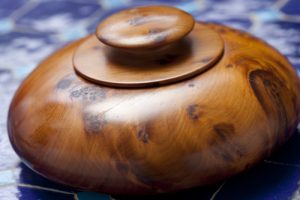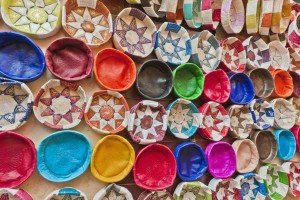Moroccan craftsmen have been creating finely decorated items for centuries. The influence of the country’s Islamic heritage and the richness of the Arabic script are seen in the beautiful everyday items, which are created using a holistic approach.
The souks, where many crafts can be found, offer a brilliant display of a vibrant living culture which has inspired international designers, whether it is a Beni Ouran carpet with deep white woollen pile, or a thuya wooden box covered with mother of pearl.
Here’s a guide to Morocco’s best arts and crafts, including where to find them, and what to look for in terms of quality and style.
Carpets
Carpets, perhaps Morocco’s most famous textile, include city designs inspired by Arab or Turkish motifs, to traditional Berber thick pile rugs that keep out the cold, to colorful flat-weave kelims which are easy to carry back home. Each carpet is a unique piece reflecting tribal history, with geometric patterns based on themes such as the Tree of Life. They are normally made from a mix of handwoven wool silk and cactus fibers and colored with natural dyes.
You can find carpet sellers in the main souks of Fez, Meknes, Marrakech and Essaouira, or you can try your luck in the smaller souks around Marrakech, such as Amizmiz souk on a Tuesday. Buying a carpet is usually accompanied with heavy bargaining and glasses of mint tea to get the best price.
Berber jewelry
Berber jewelry is created by artisans from the south of Morocco, and a wealth of different choices are available. It is usually made from silver or bronze, and depicts geometric and floral designs. In addition to pendants, earrings, bracelets and necklaces, you can also get specialty items like triangular fibulas with colored stones that are used to fix cloaks (called burnous). Jewelry is not just for the benefit of tourists in Morocco — it still plays a part in everyday life — for example, it is still an important part of a bride’s dowry in traditional areas.
The best places to buy Berber jewelry are the jewelry souks in Tiznit or Taroudant, and jewelry shops in Fez. Care needs to be taken in verifying that an item is actually silver, as there are imitations. For example, Tuareg jewelry from the south — especially the Berber Cross and the Hand of Fatima — are popular, but imitations abound. If budget is an issue, be sure to haggle to get a fair price — it is expected.
Woodwork
Thuya wood crafts are also an attractive buy for tourists. You can get everything from chess sets, to ornate boxes (often inlaid with mother of pearl), to wooden bowls, to furniture, including tables and carved screens.
Although wooden artifacts are available all over Morocco, the best place to get them is the fortress port town of Essaouira, where the Thuya trees grow along the Atlantic coast. In the workshops beneath the cannon-lined ramparts you can smell the scent of the Thuya wood and see the craftsmen carving and chiseling — it’s a must-see experience.
If you can’t make it to Essaouira, there are two magnificent showrooms at the farther end of the Souk Semarine in Marrakech. The display includes giant globes and magnificent inlaid mother of pearl chests and boxes. The Semarine souk also has wooden images of Tintin and his dog Snowy, which fit well with Art Deco interiors.
Carved wooden ceilings are also a common sight all over the Middle East, and you can see a fine example of this in the Dar Si Said Museum in Marrakech (off the Rue Riad Jedid al Zitoune, in the medina).
Metalwork
Metalwork is another magic medium of the Moroccan artisan. Copper and brass items include trays with ornate hammered designs, wrought-iron and pierced lanterns, mirror frames, and tables with hand-carved zellige-tile inlaid tops. You can also acquire custom-made, contemporary designer furniture which you can find in the ironworkers’ souk near the Madrassa Ben Youssef in Marrakech (off rue Yugoslavie). One of the best is Yahya Rouach, who has created modern renderings of classical Arabic designs for brass lamps which scatter exquisite shadows on walls. His workshop in employs skilled craftsmen who are preserving the heritage of Syrian artisans — which has been devastated by the recent conflict there. Whilst the craftsmen in the medina produce essentially repetitive designs, Yaha’s work in his showroom exhibits a fusion of modern and classical Arab designs.
Leather
Moroccan leatherwork is recovering from a period when copies of European labels were readily available and indistinguishable from the branded product. Intellectual property rights intervened and now unbranded but attractive items are selling well, including poofs, leather jackets, boxes, book covers, briefcases, satchels and bags. The best shop in Morocco for colored leather boxes, book covers or desk sets is Mourad El Maadani’s Dar Nass Maison de Cuivre at the Ensemble Artisanale (on Avenue Mohammed V opposite the Cyber Park in Marrakech).
Ceramics
Three cities in Morocco are especially known for their ceramic artistry: Meknes, Safi and Fez. Together, they produce at least 80% of the pottery in the country. Items range from ordinary earthenware tagine cooking pots, to brilliant cobalt blue-and-white glazed bowls.
The best known workshop in Fez is Art Naji, about a half-mile outside Bab el-Ftouh, the southeastern gate to the Old City. Here you can take a tour and watch craftsmen (and women) chip mosaic tile pieces, paint fanciful designs on plates, assemble elaborate mosaic tile fountain backsplashes and fashion tagines on foot-driven potter’s wheels. At the end of the tour you’ll find yourself in the shop (of course), where everything they make is ready for you to buy and ship back home. Click here to see a slideshow of the amazing variety of ceramics in Fez.




